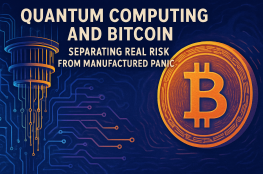It’s been a year since I made the decision to start managing some of my retirement savings myself, rather than delegating that role to someone else. So… it’s time for a check-in. How am I doing?
My family knows I’m very into bitcoin, and my parents keep warning me: “Don’t put all your eggs in one basket, you should diversify.” Fair enough. But diversify into what, exactly? If you believe the traditional financial system is collapsing and rigged against the average person in the first place, how should you invest?
That question got me thinking. About a year ago, with bitcoin ETFs launching and the lines between bitcoin and TradFi starting to blur, I realized it was past time for me to learn more about the legacy system I had mostly ignored. So I opened a Rollover IRA and started managing some of my own retirement savings. I wanted to understand the tools of the TradFi world—how to buy ETFs, how stock markets function, and what it would mean to put my worldview to the test with some real money on the line. This experiment was limited to my Rollover IRA account which I now actively manage, and I was comfortable playing around in there because it is not my only retirement account, but it is the only one I have direct control over, so it was perfect for this experiment.
There were several goals: learn how the system works, diversify away from pure bitcoin, and maybe get some exposure to bitcoin-related TradFi instruments. But mostly, I wanted to see how my macro view of the world (my read-on inflation, energy, and long-term value) held up in practice. I also wanted to compare my results to those of my new employer-managed 401k opened at the same time. Could I beat it? Could I grow this account more aggressively than my 401k?
For years, I had kept my bitcoin in self-custody, ran my own node, and knew how to generate private keys from dice rolls. But I realized that I didn’t know how to buy an ETF, read a stock chart, place a limit order, or what a “Free-Ride” violation was. I still believe that bitcoin in cold storage self-custody is absolutely the best thing anyone can own, but that strategy does get a bit boring, and I wanted to learn something new. This was that next learning frontier for me. Like with bitcoin, I decided the best way to learn was by doing.
I had some retirement savings from an old job sitting in a money market account, slowly losing purchasing power. The Rollover IRA was the best vehicle to give me the freedom to experiment. So that is what I did.
Well… In retrospect, I kind of failed on the whole “diversify away from bitcoin” goal, but now this weird portfolio I’ve built is actually performing very well.
When I first opened the account, I bought familiar, comfortable things: $NVDA, $MSFT, $DELL, and a couple funds like $VOO and $NANC. I was doing okay—not great, not terrible. I held some stocks that I had strong conviction in, like $NVDA, $B, and $CCJ, but I quickly learned that believing something is a good long-term investment doesn’t mean it’s going to be profitable in the short or medium term.
In fact, I still have a bunch of small positions in weird little companies I thought were hidden gems… and many of those are currently down 50% or more. Maybe the long-term story plays out, but yeah—let’s just say the early small-cap chapters weren’t encouraging.
Over time, and this happened gradually, I abandoned the idea of diversifying away from bitcoin. Why would I sell my best performing asset just to reallocate into a bunch of relative underperformers? That felt backwards—why shift capital out of my best-performing asset just to give the laggards a chance to catch up?
So I pivoted the experiment. It wasn’t about diversification anymore. It became about using this IRA to invest in things that:
- Are not bitcoin (because the bitcoin part of my portfolio lives elsewhere in cold storage),
- I have real conviction in,
- Align with my macro thesis, and
- Behave similarly to bitcoin in terms of long-term value and narrative.
That thesis, roughly, is:
- Monetary inflation is real and persistent. So I want real assets that act as inflation hedges and that the government cannot make more of.
- Energy and data infrastructure are foundational.
- Nuclear power is going to have a moment. So uranium stocks might outperform.
- Pay attention. News and global macro events matter and can be actionable.
So what is actually in my portfolio now? Still a lot of bitcoin, some bitcoin mining companies, and gold and uranium stocks.
I decided to completely move away from any kind of managed funds. While the strategy of having someone working for you making decisions within a fund initially made sense, it wasn’t in keeping with my experiment to take control and sovereignty over my funds and decisions. About halfway into the year, I decided: no more funds (except for $FBTC); moving forward, I would be in stocks only that I chose.
So I have a sizeable chunk of my portfolio allocated to $FBTC. I chose $FBTC as my preferred bitcoin ETF vehicle because they (Fidelity) hold their own keys to the underlying bitcoin in the fund, which is not only smart but also aligns with my thesis. I also own a meaningful position in $MSTR, which has become a unique and high-volatility proxy for bitcoin exposure. Unlike an ETF, $MSTR carries company-specific risk and leverage, but it also offers asymmetric upside when bitcoin performs well. Optimization of their new metric of increasing “bitcoin per share” has shown to be an interesting and novel Strategy. This position has done incredibly well and reflects my belief that carefully selected equities can do more than passively track—they can amplify a well-informed thesis.
I also bought several small positions in bitcoin mining companies—which may or may not work out. I think the relationship between bitcoin and mining stocks is similar to the dynamic between gold and gold miners; they’re connected, but definitely not the same thing and companies bring along risks that commodities don’t have.
Speaking of gold, that’s also a meaningful part of my holdings. It plays the classic role of an inflation hedge and a safe haven. Another important metal in the mix is uranium. As the world wakes up to the importance of stable base-load power—especially for data centers, infrastructure, and human development—uranium is poised for a potential long-term breakout.
Together, these sectors -bitcoin, gold, and uranium- form the core of my strategy. And so far, this mix has served me well.
Now, to be clear, I’m just a small retail investor (probably very small actually). And retail traders often get wrecked because there are a lot of systems working against us. The game is stacked against small players trying to time markets or chase obscure trades all while acting on delayed information during a short window of “trading hours” (seriously? What’s that about?). But retail traders do have a few advantages—and one of them is speed. If something major breaks on Twitter (X?) at 8:12 a.m., I can place a trade at 8:14. Institutional investors, meanwhile, are still setting up the boardroom slideshows waiting for consensus approvals. For example, I snagged a quick $CEP position hours after Jack Mallers announced his plans for a future SPAC merger into $XXI, and I’m up significantly from trading on that fresh information. I’ve used this advantage a few times to front-run meaningful moves—not perfectly, and not every time—but enough to see that being plugged in to the news has value.
That said, I’m not trying to “day trade,” “swing trade,” or chase meme stocks. The goal is simple: allocate to high-conviction positions that I believe will outperform inflation and beat money markets over the long haul. (Side note: money markets are kind of like TradFi’s version of stablecoins—you might get a little yield, but you’re still just treading water).
I make a few trades per month; about one per week on average. I check in a couple times per week and make changes as current events and my thesis dictate.
My best trade? On January 10th, 2025, I sold my $NVDA position and rotated the proceeds into $MSTR. Since then, MSTR has significantly outpaced NVDA—delivering gains nearly 20% higher over the same timeframe. That wasn’t just luck. It was a conviction-based pivot aligned with my broader thesis: that bitcoin and its proxies were poised to outperform mainstream tech as narrative momentum shifted. By recognizing that NVDA’s AI boom may have plateaued short-term, and that MSTR offered asymmetric upside as a bitcoin proxy, I made a deliberate, strategic allocation that paid off.
On the flip side, some of my worst trades include $STI, $CRML, $HIVE and $CASK. Those companies adopted a bitcoin treasury model—something I thought would act as a bullish signal. But as it turns out, simply putting bitcoin on the balance sheet isn’t a magic bullet, at least so far. These companies have continued to lose significant value, and in one case I even got to learn what a reverse stock split is (the hard way). The lesson? Bitcoin can preserve value, but it can’t fix a broken business model. Going forward, I believe the best opportunities lie in companies that either are pure bitcoin plays or integrate bitcoin treasury strategies into already healthy and operationally sound businesses.
The goal was to manage my own retirement portfolio, test my macro thesis, and see if I could outperform the passive system. So—did the experiment work?
As of this writing, my portfolio is up +30.88% overall since I started.
Not bad for someone who used to think ETFs were some kind of energy drink.
That number alone is encouraging. But returns without context can be misleading. So let’s dig a little deeper. What are the metrics that actually tell me whether this experiment is working?
Evaluating Performance: Sharpe Ratio, TWR, and IRR
The following metrics help me move beyond gut feelings and toward actual analysis of whether my strategy is effective—and whether my decisions are helping or hurting.
Sharpe Ratio: Measuring Return per Unit of Risk
The Sharpe Ratio is one of the most important measures of portfolio efficiency—it tells you whether you’re being adequately rewarded for the risk you’re taking. My portfolio’s estimated Sharpe Ratio is 1.28, based on a +36.89% annual return and moderate volatility. That’s a strong result, well above what you’d expect from an index fund like $VOO, which typically hovers between 0.6 and 1.0. For comparison, bitcoin’s Sharpe Ratio over the same period is approximately 2.00—an impressive figure driven by its explosive returns, but with extreme volatility. My portfolio, built around bitcoin-adjacent and hard-money-aligned stocks, shows that it’s possible to achieve strong risk-adjusted returns while still sleeping at night. However, it’s important to note here that this crazy Sharpe ratio suggests it would have been better for me to just hold bitcoin itself rather than all these other assets I’m playing with. Over this time period, bitcoin outperformed my whole portfolio on a risk-adjusted basis.
Time-Weighted Return (TWR): Judging the Strategy Itself
TWR is the cleanest way to judge a portfolio’s performance independent of my behavior. It tells me how well my investment selection and thesis performed, assuming I had invested once and let it ride. (In essence, it answers the question: “How did my strategy do, regardless of when I bought or sold?”) Over the past year, my TWR is +36.89%, which significantly outperformed $VOO (up around 24%) and absolutely crushed bond funds, which have hovered near flat or slightly negative. This shows that my bitcoin-aligned strategy—investing in miners, uranium, energy infrastructure, and scarcity-based plays—is working. Even without perfect trade timing, the strategy itself has delivered strong returns.
Internal Rate of Return (IRR): Judging My Decisions
IRR (also called Money-Weighted Return, or MWR) reflects my actual, lived experience as an investor. It accounts for when I added money, bought shares, or rebalanced. (In other words, it asks: “How did I do with my decisions?”) My IRR over this past year came out to +38.39%, slightly higher than my TWR. That may not sound like a big difference, but it’s a small victory—it means my hands-on decisions actually helped, not hurt. Many investors underperform their own portfolios by buying high and selling low. In this case, my conviction-driven timing (including a few well-placed periodic contributions) nudged performance up a bit, rather than dragging it down.
Conclusion
The results support my thesis: assets tied to scarcity, energy, and decentralization can outperform when approached with discipline and conviction. Bitcoin, gold, and uranium aren’t just narrative-driven plays, they’re reflections of a world undergoing deep structural change. Owning them isn’t just a bet on price; it’s a stance on where value is migrating.
Performance-wise, this portfolio didn’t just work, it outpaced almost everything else I could have chosen. With a TWR of +36.89%, it significantly beat the S&P 500 (up roughly 24%) and left bond funds in the dust. And compared to my professionally managed 401k, which returned just +1.36% TWR over the same period, it’s not even close.
That single number speaks volumes. It shows the cost of passivity and letting others make decisions for you, the pitfalls of blind diversification, and the upside of owning a thesis and acting on it.
I didn’t start this experiment to prove anything. I started it to learn. And I’ve learned a lot: about markets, about measuring risk, and about how I make strategic decisions aligned with a guiding idea. I’ve made some great trades and some forgettable ones. But I’ve owned every choice and no fund manager can do that for me.
If there’s a lesson I’d share with others, it’s this: don’t let other people think for you when it comes to your money and future. Taking responsibility for your financial life isn’t easy, but it’s empowering. Learning to make decisions based on your own thesis, with your own risk tolerance, is one of the most valuable skills you can develop. For me, this wasn’t just about beating the market. It was about reclaiming agency—learning to navigate the financial system without relying on opaque institutions or passive vehicles that don’t reflect my values.
Looking Forward
So this is where my portfolio more or less sits now. I’ve learned a lot. I’m still heavily exposed to bitcoin, and over the past year (and the past decade), that’s helped me far more than it’s hurt me. Is it time to pivot? I don’t think so. I won’t be “taking profits” any time soon with bitcoin trading near all-time highs and more and more regulatory hurdles clearing by the day. I might take some profits from positions like $MSTR and other companies if I feel the need to. But don’t expect me to return to bond funds or broad index ETFs either. I’ve found my lane, and for now, I plan to hodl in it.

Andrew Lonero is a geochemist, lab manager, and Bitcoin advocate with a deep interest in complex systems, both natural and digital. He runs a geochemical research lab focused on environmental systems and climate change, where he works with high-precision scientific instruments such as mass spectrometers to analyze the elemental and isotopic composition of materials. His passion for technology extends beyond the lab, with a long-standing interest in computer hardware, from GPUs to Bitcoin nodes and ASICs.
Andrew first became involved with Bitcoin in 2014, drawn to its open, decentralized nature and its intersection with energy, computing, and financial inclusion. Much like his work in geochemistry, where he deciphers intricate natural systems, he sees Bitcoin as a technological system that requires careful analysis, optimization, and innovation. Through the Progressive Bitcoiner Organization, Andrew is excited to support research that explores Bitcoin’s role in sustainability, economic justice, and social impact.




